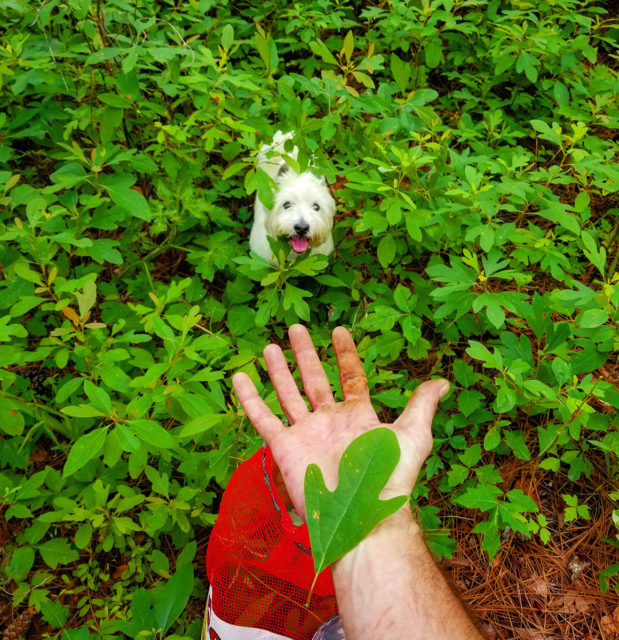Fall 2019
Suffering Sassafras
Insensitive harvesting threatens an iconic Louisiana ingredient
Published: August 30, 2019
Last Updated: March 22, 2023

Photo by Dustin Fuqua
Filé maker John Oswald Colson stands next to a sassafras tree in the Kisatchie National Forest.
If gumbo is the heart of Louisiana cuisine, then filé might be its soul. A common ingredient in gumbo (depending on whose house you’re in), filé can add an earthy dimension or texture to the dish when okra isn’t in season. It’s a uniquely Louisianan ingredient in a uniquely Louisianan dish.
Filé also has medicinal value. The powder is traditionally used in poultices to treat insect stings, burns, and rashes, while folk healers use tea brewed from the sassafras root to treat fevers, colds, eczema, arthritis, and liver problems.
While you can find the mass-produced version of filé on the shelves of every grocery store in the state, nothing beats harvesting the sassafras fresh and drying it yourself. Not according to some Cane River Creoles, anyway.
One such filé-making master is John Oswald Colson. He’s so well-known for it that in 2018 Lt. Governor Billy Nungesser named him a Louisiana Tradition Bearer. Often joining him on harvests is his protégé and friend Dustin Fuqua, Chief of Resource Management at Cane River Creole National Historical Park. But according to Fuqua, not much sassafras grows around Cane River anymore.
“People used to go with a machete or a cane knife and just cut the limbs,” he says, a practice that makes it impossible for sassafras trees to regrow.
Instead, Colson and Fuqua head for the hills in the Kisatchie National Forest, relying on word of mouth from older locals and the Forest Service to find pockets of sassafras. They also get a permit from the Forest Service for harvesting on government land.
August 15—the Catholic Feast of the Assumption—is the traditional harvest date. That’s when more sap is said to be in the leaves, boosting the plant’s medicinal properties. Colson, now in his eighties, can remember picking sassafras around August 15 as a kid. Perhaps because of climate change, he and Fuqua have had to start picking earlier in the summer.
“I challenge anybody to find good sassafras that you can pick on August 15,” says Fuqua. By then, the leaves have started to discolor or have been eaten by animals.
The shift in harvest times is another sign of how important it is to practice sensitivity when picking.
“We pick the leaves by hand, one by one,” says Fuqua. “We don’t cut the branches.”
He notes that they stand on his truck to reach the leaves, if need be.

Picking sassafras. Photo by Dustin Fuqua
Once they’ve filled several sacks’ worth of sassafras, they then take it back to Colson’s house and spread the leaves across the floor. Over the course of two to three weeks, Colson turns the leaves by hand while the air conditioning dries them out. This is more laborious than the insensitive method of cutting the entire branch, which harvesters could then hang in the rafters of their attic and allow to dry.
After drying, Colson and Fuqua destem the leaves before grinding them down into a powder with a pile and pilon, a set of tools like a mortar and pestle originally used by the Choctaw Indians. The result is a fine, bright green powder that stands in stark contrast to the sawdust-like color and consistency of commercially produced filé. It’s no wonder that people would rather buy from local makers or make it themselves.
Fuqua acknowledges that the disappearance of sassafras around Cane River is likely rooted in local economics. Anyone can pick leaves, pound them into filé, then sell a bottleful for five or ten dollars each.
“If you can go pick and make money off of it, then you’re going to do that,” he says.
To combat insensitive harvesting practices, Colson and Fuqua give presentations at folklife festivals and events around the state. It’s one of the reasons why the Forest Service issues them a permit to harvest each year.
“We do so many public demonstrations with [the sassafras]—otherwise they wouldn’t allow it,” says Fuqua.
They’ve also begun educating visitors at Cane River Creole National Historical Park about the tradition, and a documentary film they’ve made about filé will soon be available to the public. They hope to inspire Louisianans to keep exploring their cultural traditions, but to do so in a way that honors the history and spirit of those practices.
“All of these traditions have a protocol to them,” says Fuqua. “There’s a certain time of the year, a certain way to do it, a certain etiquette about it.”
One could also argue that the soul of Louisiana cuisine tastes better when you put soul into making it.
Check out 64 Parishes’ video on sassafras harvesting in Kisatchie National Forest.
Morgan Randall is a writer, marketing consultant, and full-time road-tripping van dweller. She’s the author of no books and has no credentials, but she’s an expert at asking the right questions to people who are more knowledgeable than her. You can find her fueling up at your local rest stop or at morganeliserandall.com.
